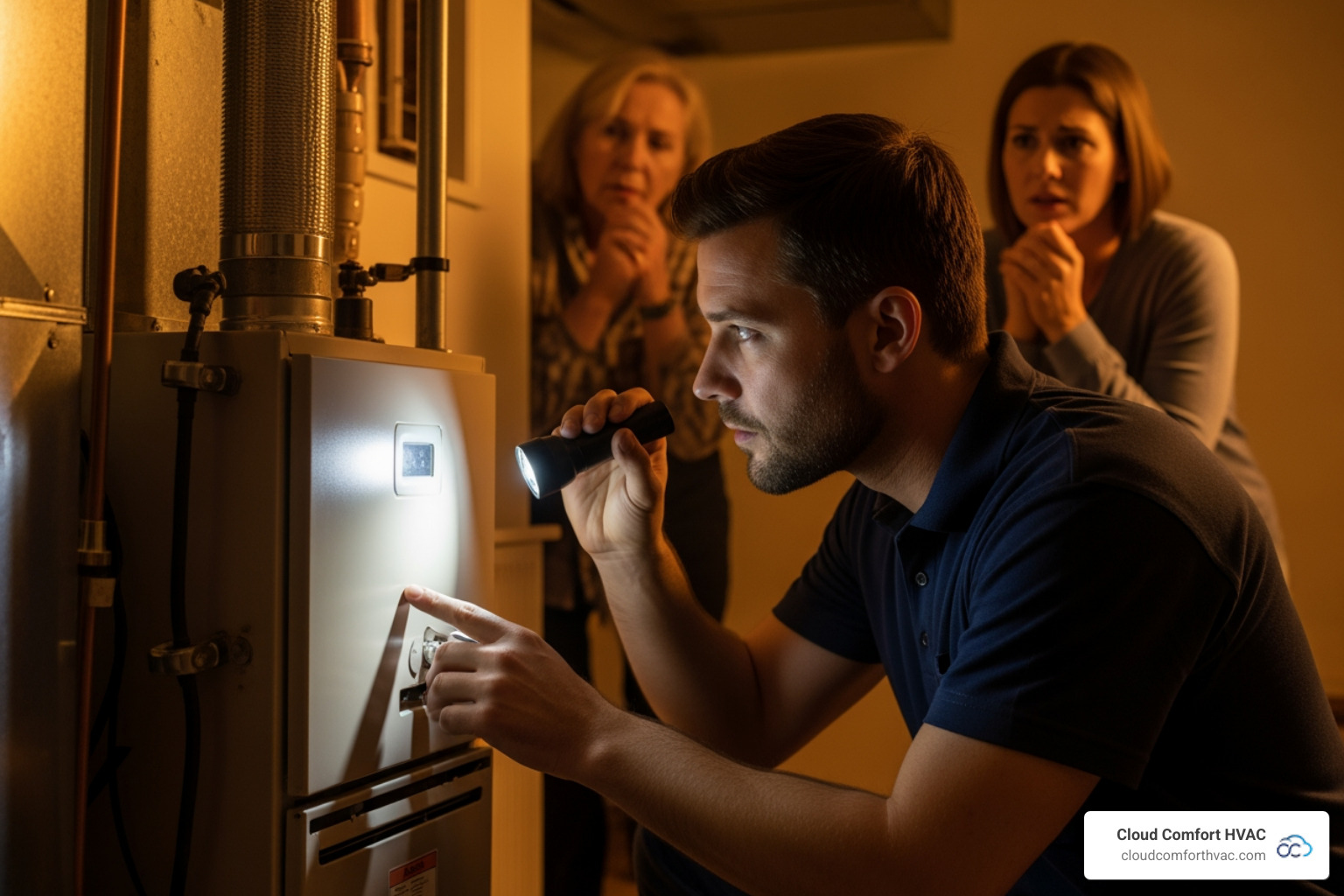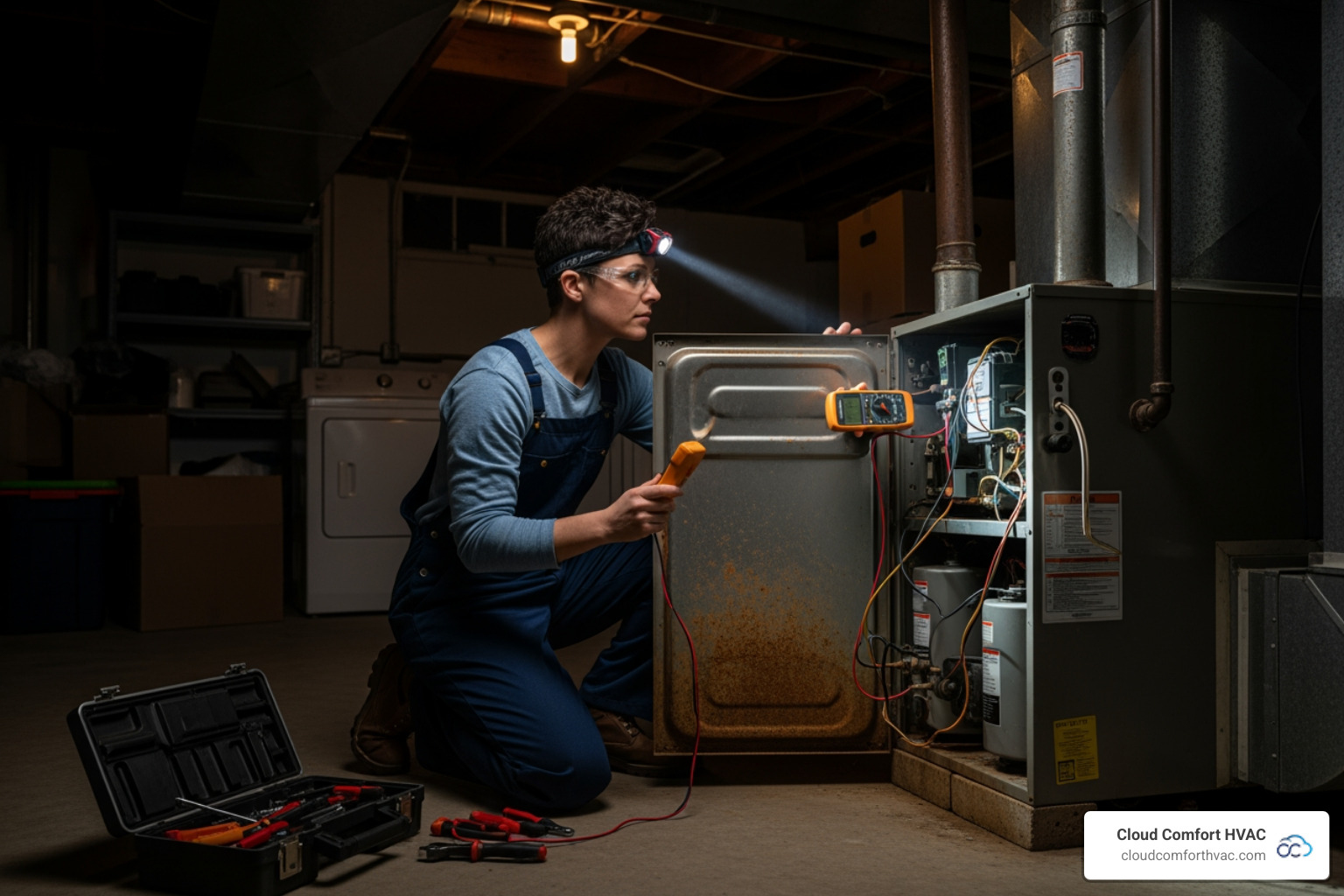Don't Sweat It: Common Ductless AC Issues & How to Fix Them
Why Your Daikin Mini-Split Might Be Acting Up
Daikin mini split problems can turn a comfortable home into a frustrating experience. Whether your unit won't turn on, isn't cooling properly, or is making strange noises, you're not alone—these issues are common.
Here are the most frequent Daikin mini-split problems and their quick fixes:
Power Issues:
- Unit won't turn on - Check circuit breaker and remote batteries
- No response from remote - Replace batteries or check for interference
Performance Problems:
- Poor heating/cooling - Clean air filters and check outdoor unit for obstructions
- Short cycling - May indicate oversized unit or refrigerant issues
Mechanical Issues:
- Water leaks - Clear clogged condensate drain line
- Strange noises - Tighten loose components or call for motor issues
- Bad odors - Clean unit and check for mold growth
System Errors:
- Error codes displayed - Consult manual for specific code meanings
- Frequent shutdowns - May need professional diagnosis
The good news? Many of these problems have simple solutions you can try yourself. As one HVAC expert noted, "While certain issues require professional expertise, others can be resolved with simple do-it-yourself methods."
Regular maintenance is your best defense, especially as systems older than 15 years become more prone to breakdowns. Before you panic about expensive repairs, let's walk through the most effective troubleshooting steps to save you time and money.
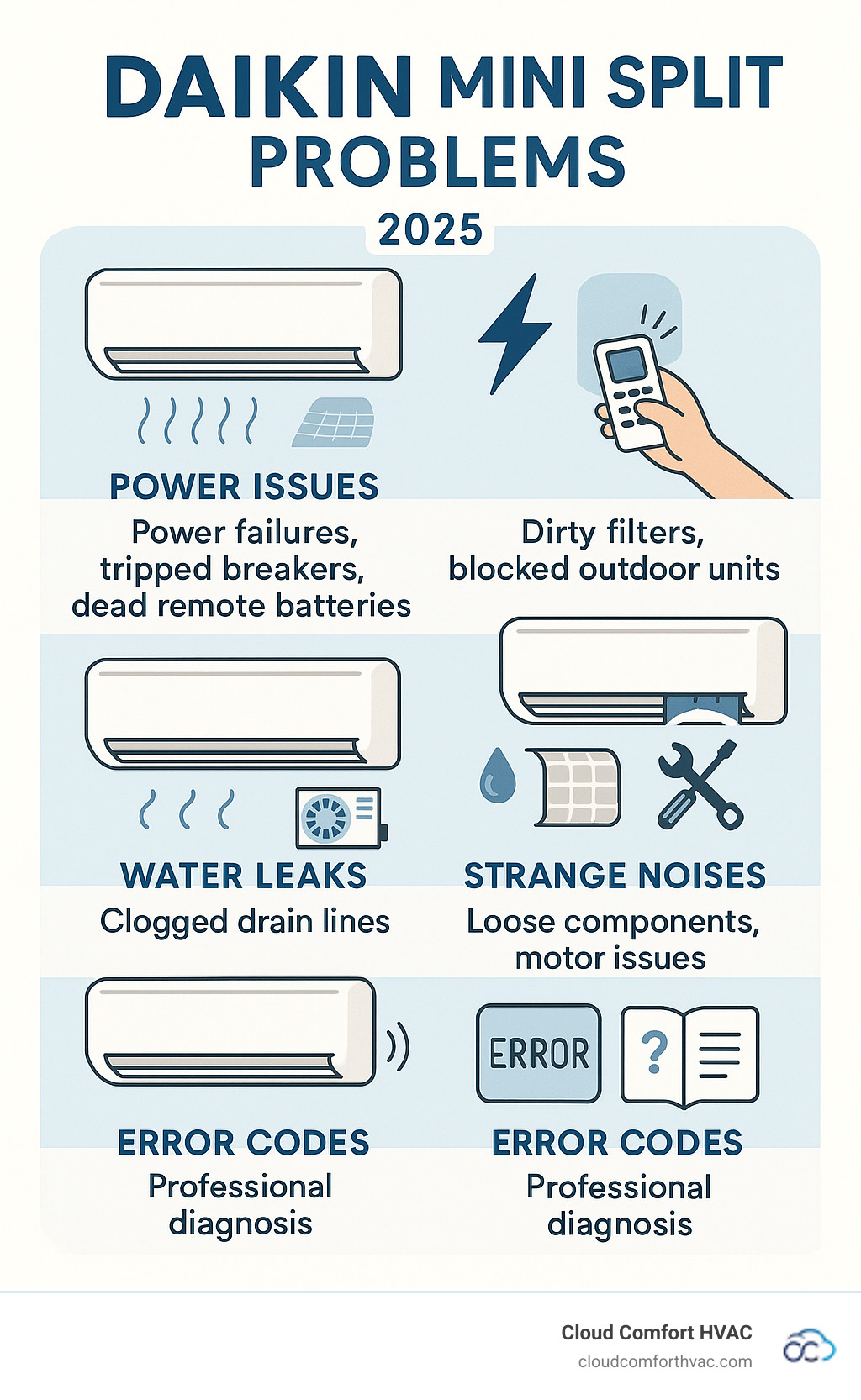
Initial Checks: Simple Fixes Before You Call
When your Daikin mini-split acts up, don't immediately call for service. Many common Daikin mini split problems have simple solutions you can handle yourself. Performing these initial checks can save you time and money.
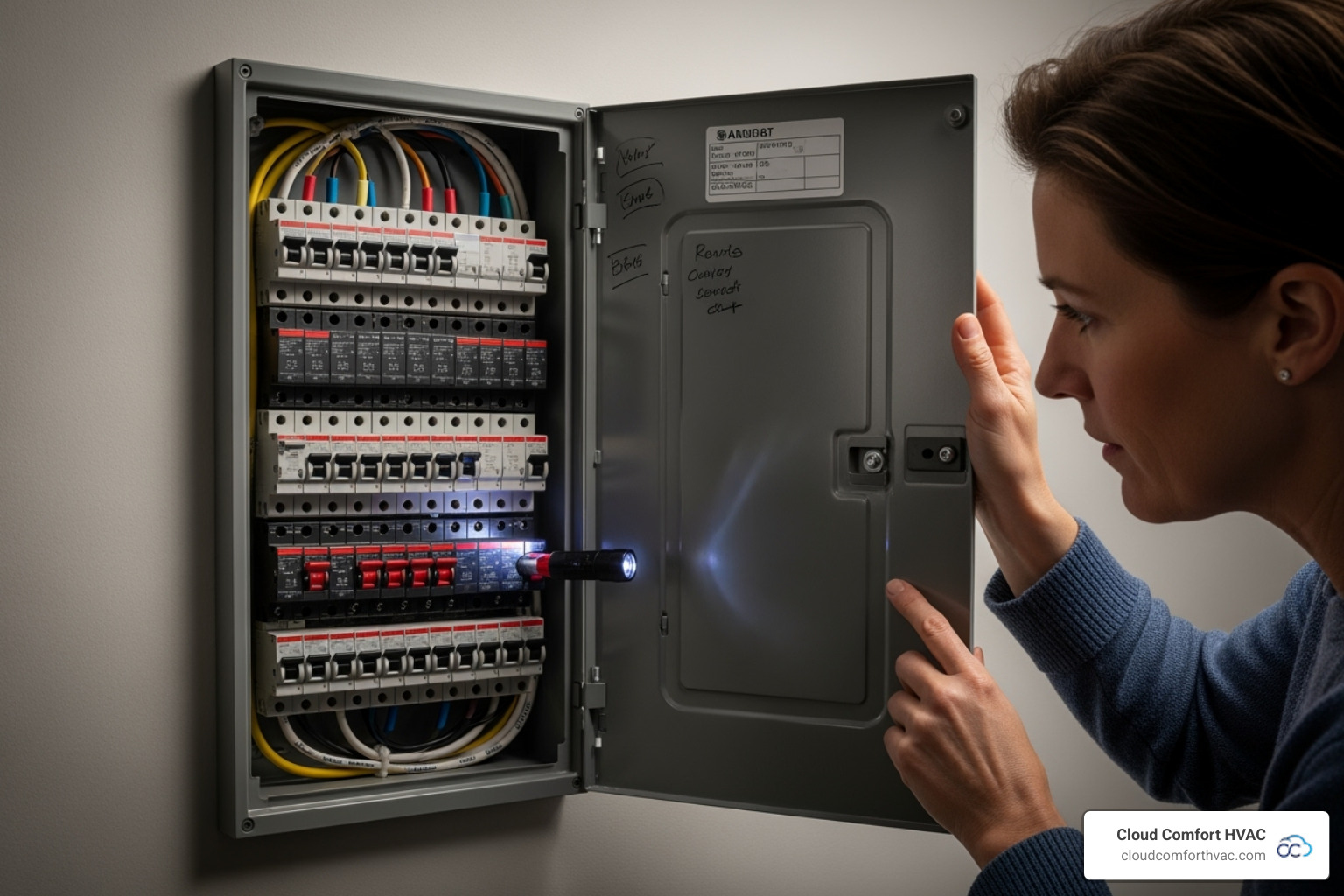
Why Won't My Daikin Mini-Split Turn On?
A mini-split that won't power on is frustrating. Let's walk through the common culprits.
First, check the power supply. Go to your electrical panel and find the circuit breaker for your mini-split. If it has tripped, you'll see it in an 'off' or middle position. Flip it fully to 'off,' then back to 'on.' For older fuse boxes, check for and replace any blown fuses. Also, ensure the unit is securely plugged in. After a power outage, a manual check is sometimes needed, even though Daikin units are designed to restart automatically.
Next, check the remote control, a common source of "no power" issues. The most frequent culprit is dead batteries; pop in a fresh set of alkaline batteries, which typically last about one year. Ensure the remote is set to 'On' and the correct mode (heating, cooling, auto). Also, check for obstructions like direct sunlight or other electronics (fluorescent lamps, TVs) that can block the signal to the indoor unit.
Sometimes, the unit is just taking a break. In cold weather, a Daikin in heating mode may enter a defrost cycle to melt ice buildup on the outdoor unit. This is normal operation, not a malfunction. The system will pause for 3 to 10 minutes and then resume automatically. This pause can be mistaken for a power issue.
Daikin units have built-in protection measures. If you restart the unit or change modes too quickly, a protective 3-minute delay may occur to protect the compressor. This is normal. Similarly, if the unit stops but the operation lamp is on, it could be due to voltage fluctuations; it should restart automatically in about 3 minutes.
For stubborn issues, try a "global reboot." Turn off the circuit breaker for your mini-split for at least 10-30 seconds (some experts suggest up to 20 minutes for a full reset), then flip it back on. This can clear minor glitches or internal communication errors.
If these checks don't work, it may be time for professional help. But you've just ruled out many common Daikin mini split problems yourself!
Performance Problems: Why Isn't My Daikin Heating or Cooling?
It's frustrating when your mini-split blows lukewarm air instead of heating or cooling effectively. This is one of the most common Daikin mini split problems homeowners face.
Fortunately, many performance issues have simple solutions. Let's review the likely culprits to get your system back to doing what it does best.
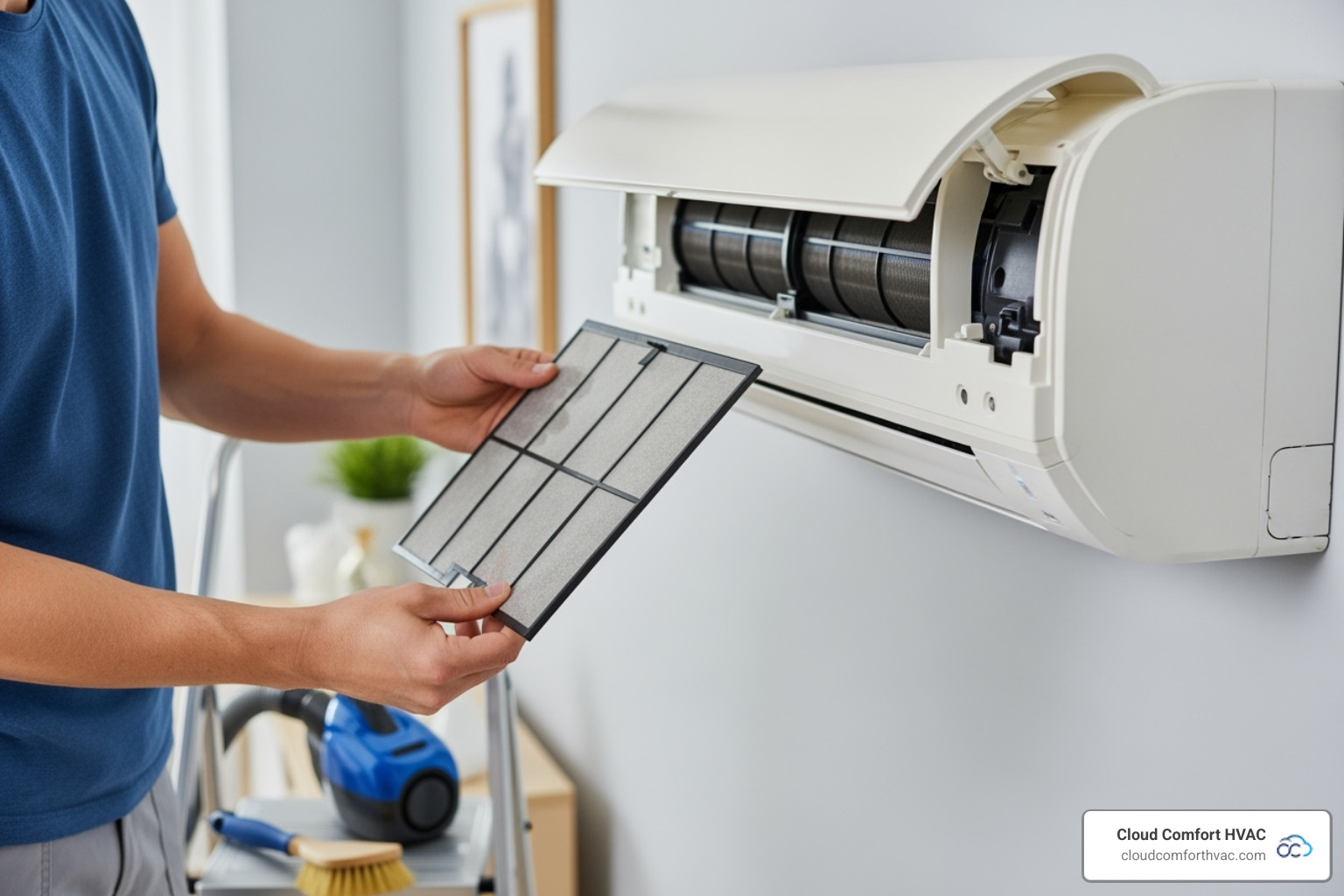
Troubleshooting Ineffective Heating and Cooling
When your Daikin isn't performing, start with the simplest explanations.
Check your settings first. It sounds obvious, but ensure your unit is set to the correct mode for the season (heating or cooling). Verify that your temperature setting is appropriate and that your remote's batteries aren't low.
Dirty air filters are the number one performance killer for mini-splits. When filters get clogged with dust and particles, your system has to work much harder to push air through. This restricted airflow reduces heating and cooling effectiveness, wastes energy, and can shorten your system's lifespan.
The fix is simple: clean or replace your filters every one to three months, or more frequently if you have pets or allergies. Most filters can be gently vacuumed or rinsed with water. Use a mild detergent for stubborn dirt and let them dry completely before reinstalling.
Your outdoor unit also needs breathing room. Check for leaves, grass clippings, or other debris around the condenser coils. Overgrown bushes can also impact efficiency.
Winter brings challenges with snow and ice buildup. While some frost is normal, heavy accumulation blocks airflow. Gently clear away snow, avoiding sharp tools. If your unit enters defrost mode frequently (the outdoor fan stops and you may see steam), this is normal winter operation.
Refrigerant levels are another critical factor, but this is not a DIY fix. If your system runs constantly but barely cools, or you see ice on the indoor coils, you might have a refrigerant leak that requires professional attention.
System age plays a role. Daikin mini-split systems are durable, but units over 15 years old become less efficient. Regular maintenance is crucial for older systems.
Poor sizing can also be the problem. An oversized unit might cycle on and off too quickly, failing to dehumidify or distribute air evenly, creating uncomfortable hot and cold spots.
If these steps don't restore performance, it's time to call a professional for specialized diagnosis.
Decoding Your Unit: Leaks, Noises, and Odors
Daikin mini split problems can be obvious: water leaks, strange noises, or unpleasant odors. These sensory clues often point directly to the issue, telling you what's going wrong with your system.
Let's decode what your unit is trying to tell you.
What to Do About Water Leaks and Nasty Smells
A water leak from your indoor unit demands immediate attention to prevent water damage.
The most common culprit is a clogged condensate drain line. As your mini-split cools and dehumidifies, it produces condensation that should flow outside through a drain line. When this line is blocked by algae or debris, water backs up and overflows.
To fix this, turn off the unit. Find the condensate drain line (usually a PVC pipe) outside and use a wet/dry vacuum to suck out the clog. For stubborn blockages, pouring a 1:1 water and vinegar solution into the drain pan can help break things loose.
A severely dirty filter can also cause water leaks by restricting airflow, causing the indoor coil to freeze. When the ice melts, it can overwhelm the drain pan.
Unpleasant smells are another common issue.
A musty "dirty sock" smell comes from mold and mildew on the indoor coil or in the drain pan. Regular filter cleaning helps, and many Daikin units have a "mold proof" operation that runs the fan after cooling to dry internal components.
A burning smell is a serious concern. It could signal electrical issues like burning wires or a failing motor. If you detect this smell, immediately turn off your unit at the circuit breaker and call a professional. Do not restart it.
Identifying Common Daikin Mini Split Problems by Sound
Your Daikin mini-split has a language of sounds. Learning what's normal versus what's concerning can save you worry and money.
Normal sounds include clicking on startup, gentle buzzing from moving louvers, and soft hissing or crackling from the air purifying Streamer function. Flowing water sounds during winter heating are also normal, indicating a defrost cycle.
| Normal Operational Sounds | Abnormal Noises |
|---|---|
| Clicking: Refrigerant control valve or electrical components operating | Rattling/Vibrating: Loose mounting screws, panels, or internal components |
| Flowing water: Normal defrost operation during heating mode | Grinding/Squealing: Blower motor or fan bearing issues requiring immediate attention |
| Hissing/Crackling: Streamer discharge air purifying function | Loud continuous buzzing: Faulty transformer or water pump problems |
Rattling or vibrating noises often mean something is loose. Check visible screws on both indoor and outdoor units to ensure they're snug.
Grinding or squealing sounds are red flags that point to blower motor or fan bearing problems. These mechanical issues can worsen quickly, so turn off your unit and call for professional help to prevent a simple repair from becoming an expensive replacement.
Loud, continuous buzzing may indicate electrical component failure, while loud clunking or banging suggests serious mechanical problems that need immediate professional attention.
Understanding Daikin Mini Split Problems & Error Codes
Modern Daikin mini-splits have sophisticated diagnostic systems. When something is wrong, they display error codes, making Daikin mini split problems easier to identify and resolve.
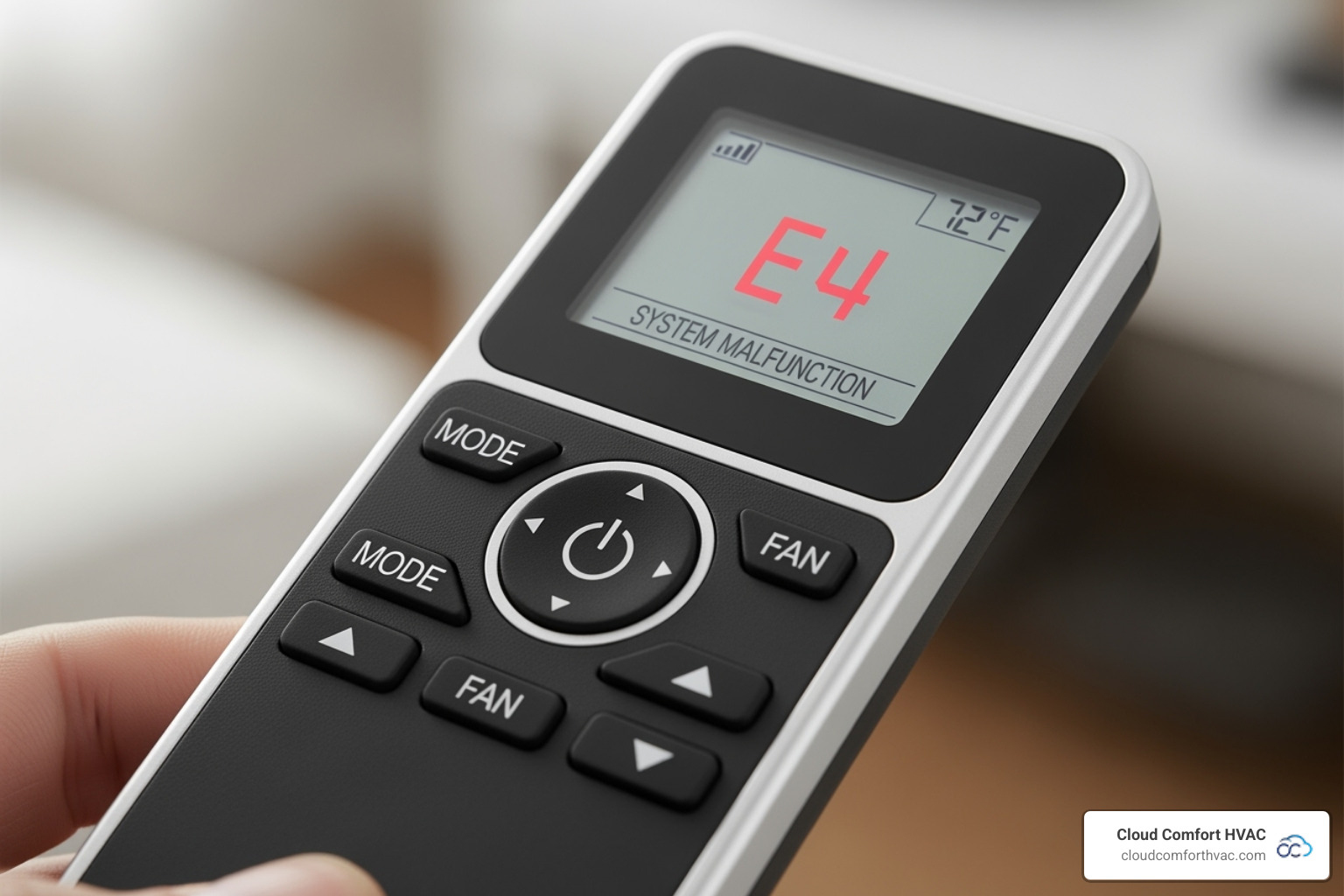
These codes appear on your indoor unit's display or remote control, giving you valuable insight into what's happening behind the scenes.
What Do Daikin Error Codes Mean?
While specific codes vary by model (always check your manual), several are common across most Daikin units.
Power and electrical issues often appear as A1 codes (indoor circuit board problem) or U2 codes (power supply voltage problem). These require professional service.
Airflow and mechanical problems include A6 codes (fan motor malfunction) and A5 codes (indoor heat exchanger overheating, often due to dirty filters or a refrigerant issue).
Drainage troubles show up as A3 codes, meaning water is backing up in the drain pan from a clogged condensate line. This is often a DIY fix.
Refrigerant and system pressure issues are more serious. U0 codes signal a refrigerant shortage (leak), F3 codes indicate dangerously high discharge pipe temperatures, and E5 codes mean the compressor is overloaded. These all require a technician.
Communication breakdowns between units appear as U4 codes, often caused by wiring problems or faulty control boards.
If an error code appears, write it down. Then, try rebooting the system by turning off the circuit breaker for 15-20 minutes. This can sometimes clear temporary glitches.
For basic issues like A3 drainage codes or A5 overheating codes, cleaning filters or drain lines may help. But for most error codes—especially those involving refrigerant, electrical components, or internal failures—it's time to call a professional.
Technicians can also retrieve stored error codes that aren't displayed, helping diagnose hidden problems. Daikin's Daikin troubleshooting assistant website can also help you decode common errors and suggest next steps.
The diagnostic system takes the guesswork out of Daikin mini split problems. Providing a specific code to a technician saves time, reduces diagnostic costs, and gets your comfort restored faster.
The Power of Prevention: Maintenance and Professional Care
The best way to handle Daikin mini split problems is to prevent them with proactive care. Like a car, your mini-split needs regular check-ups. Consistent maintenance saves money on repairs and ensures peak efficiency, lowering energy bills.
How to Maintain Your System and When to Call a Pro
Maintaining your Daikin is a team effort between DIY tasks and professional service. Some tasks you can do yourself, while others need a professional touch.
Here are the key DIY maintenance tasks:
- Clean or replace air filters every 1-3 months. Clogged filters restrict airflow, hurt performance, and increase energy use.
- Keep the outdoor unit clear of leaves, debris, snow, and ice to ensure proper airflow and prevent damage.
- Check remote and thermostat settings to ensure they have fresh batteries and are set to the correct mode and temperature.
- Wipe down the indoor unit's exterior to prevent dust buildup. Before a long vacation, run the "mold proof" mode. For extended non-use, turn off the breaker and remove remote batteries.
While these steps prevent many Daikin mini split problems, some issues require a certified HVAC technician. Knowing when to call a pro prevents minor issues from becoming major repairs.
You should call a professional if:
- Your unit has persistent issues after trying DIY troubleshooting.
- You suspect a refrigerant leak (U0 error code, poor performance, ice on coils). Refrigerant requires professional handling.
- You hear grinding or squealing noises. These indicate motor or bearing problems. Turn the unit off and call a technician.
- You smell a burning smell. This is a serious safety hazard. Turn the unit off at the breaker immediately and call for service.
- You're dealing with complex electrical issues or related error codes (like U2).
- Water leaks persist after you've cleared the drain line.
- You see error codes you can't resolve yourself.
- Your aging system (15+ years) breaks down frequently.
Investing in an annual professional tune-up offers significant benefits:
- Prevents breakdowns by catching small issues early.
- Ensures optimal efficiency and lower energy bills.
- Extends your system's lifespan, protecting your investment.
- Improves indoor air quality by removing mold, dust, and allergens.
- Maintains your warranty, as many require proof of regular maintenance.
Investing in regular maintenance is the key to preventing Daikin mini split problems and guaranteeing your home stays comfortable and energy-efficient.
Conclusion
Dealing with Daikin mini split problems can be a headache, but as we've seen, many issues have simple DIY solutions. Basic troubleshooting, from checking breakers to cleaning filters, can save you time and money on service calls.
However, know when to call in the cavalry. Some problems are too complex or dangerous for a DIY fix. Complex electrical issues, refrigerant leaks, grinding noises, burning smells, or persistent error codes are your cue to step back and call a professional for your safety and to protect your unit.
The best defense is a good offense. Regular maintenance, combining simple DIY tasks with annual professional tune-ups, is the surest way to prevent future Daikin mini split problems. It keeps your system running efficiently, extends its lifespan, and ensures you enjoy reliable, year-round comfort.
At Cloud Comfort HVAC, we're not just about fixing problems; we're about delivering peace of mind. We pride ourselves on providing fast, reliable, and eco-friendly HVAC services. With our transparent pricing, high Google rating, and strong Daikin warranties—including our unique 1-year Comfort Promise—you can rest easy knowing your comfort is our priority. Whether you're in Torrance, CA, or the surrounding areas like Rancho Palos Verdes CA, Manhattan Beach CA, Culver City CA, Palos Verdes Estates CA, or Carson CA, our team is ready to help.
Don't sweat it—we've got you covered.

.avif)
Customer Testimonials
Hundreds of 5-Star Reviews on Google Show Our Commitment to Customer Satisfaction




New Air Conditoining Unit for as low as $79/mo + Free Wi-Fi Thermostat
(Or As Low As $4,995 as a One-Time Payment)
FINANCE WITH $0 PAYMENTS & 0% INTEREST FOR 12 MONTHS, OAC
Hurry! Offer Ends Soon.



